Economics Report: Analysis of Inequality in Australia (Economics)
VerifiedAdded on 2020/04/21
|9
|1687
|120
Report
AI Summary
This economics report examines the significant socioeconomic disparities between Indigenous and non-Indigenous Australians. The analysis highlights inequalities in health, education, and employment, emphasizing the persistent 'gap' in living conditions. The report uses BMI data to illustrate health disparities, noting higher rates of obesity and related diseases among Indigenous Australians. It also points out differences in life expectancy, infant mortality, and maternal death rates. Furthermore, the report reveals substantial gaps in education levels, with lower completion rates for Indigenous people. These educational disparities correlate with inequalities in employment opportunities, including lower employment rates and inferior job quality. The report concludes that addressing these inequalities is crucial for the overall welfare and long-term sustainability of Australia's development, advocating for immediate action to close the gap and improve the lives of Indigenous Australians.
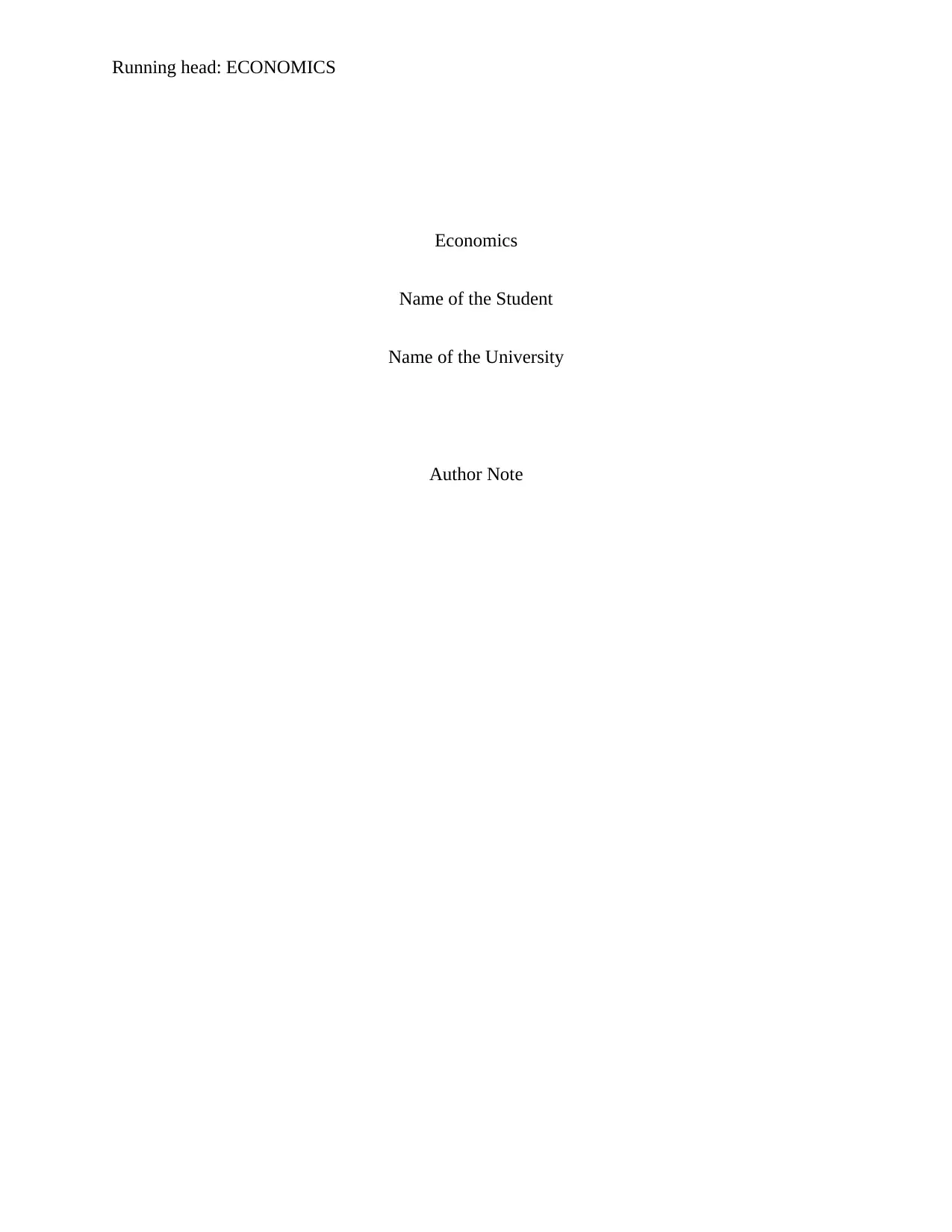
Running head: ECONOMICS
Economics
Name of the Student
Name of the University
Author Note
Economics
Name of the Student
Name of the University
Author Note
Paraphrase This Document
Need a fresh take? Get an instant paraphrase of this document with our AI Paraphraser
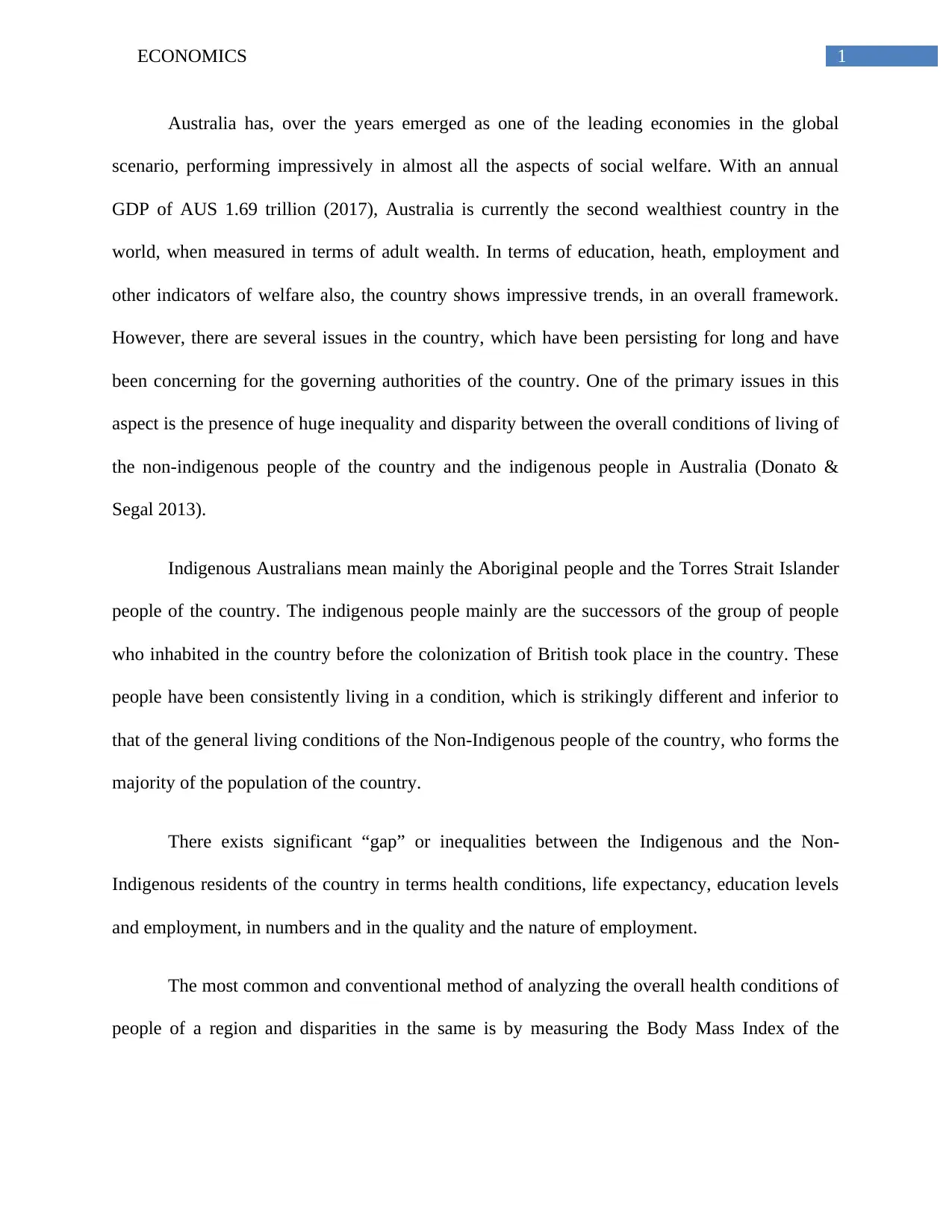
1ECONOMICS
Australia has, over the years emerged as one of the leading economies in the global
scenario, performing impressively in almost all the aspects of social welfare. With an annual
GDP of AUS 1.69 trillion (2017), Australia is currently the second wealthiest country in the
world, when measured in terms of adult wealth. In terms of education, heath, employment and
other indicators of welfare also, the country shows impressive trends, in an overall framework.
However, there are several issues in the country, which have been persisting for long and have
been concerning for the governing authorities of the country. One of the primary issues in this
aspect is the presence of huge inequality and disparity between the overall conditions of living of
the non-indigenous people of the country and the indigenous people in Australia (Donato &
Segal 2013).
Indigenous Australians mean mainly the Aboriginal people and the Torres Strait Islander
people of the country. The indigenous people mainly are the successors of the group of people
who inhabited in the country before the colonization of British took place in the country. These
people have been consistently living in a condition, which is strikingly different and inferior to
that of the general living conditions of the Non-Indigenous people of the country, who forms the
majority of the population of the country.
There exists significant “gap” or inequalities between the Indigenous and the Non-
Indigenous residents of the country in terms health conditions, life expectancy, education levels
and employment, in numbers and in the quality and the nature of employment.
The most common and conventional method of analyzing the overall health conditions of
people of a region and disparities in the same is by measuring the Body Mass Index of the
Australia has, over the years emerged as one of the leading economies in the global
scenario, performing impressively in almost all the aspects of social welfare. With an annual
GDP of AUS 1.69 trillion (2017), Australia is currently the second wealthiest country in the
world, when measured in terms of adult wealth. In terms of education, heath, employment and
other indicators of welfare also, the country shows impressive trends, in an overall framework.
However, there are several issues in the country, which have been persisting for long and have
been concerning for the governing authorities of the country. One of the primary issues in this
aspect is the presence of huge inequality and disparity between the overall conditions of living of
the non-indigenous people of the country and the indigenous people in Australia (Donato &
Segal 2013).
Indigenous Australians mean mainly the Aboriginal people and the Torres Strait Islander
people of the country. The indigenous people mainly are the successors of the group of people
who inhabited in the country before the colonization of British took place in the country. These
people have been consistently living in a condition, which is strikingly different and inferior to
that of the general living conditions of the Non-Indigenous people of the country, who forms the
majority of the population of the country.
There exists significant “gap” or inequalities between the Indigenous and the Non-
Indigenous residents of the country in terms health conditions, life expectancy, education levels
and employment, in numbers and in the quality and the nature of employment.
The most common and conventional method of analyzing the overall health conditions of
people of a region and disparities in the same is by measuring the Body Mass Index of the
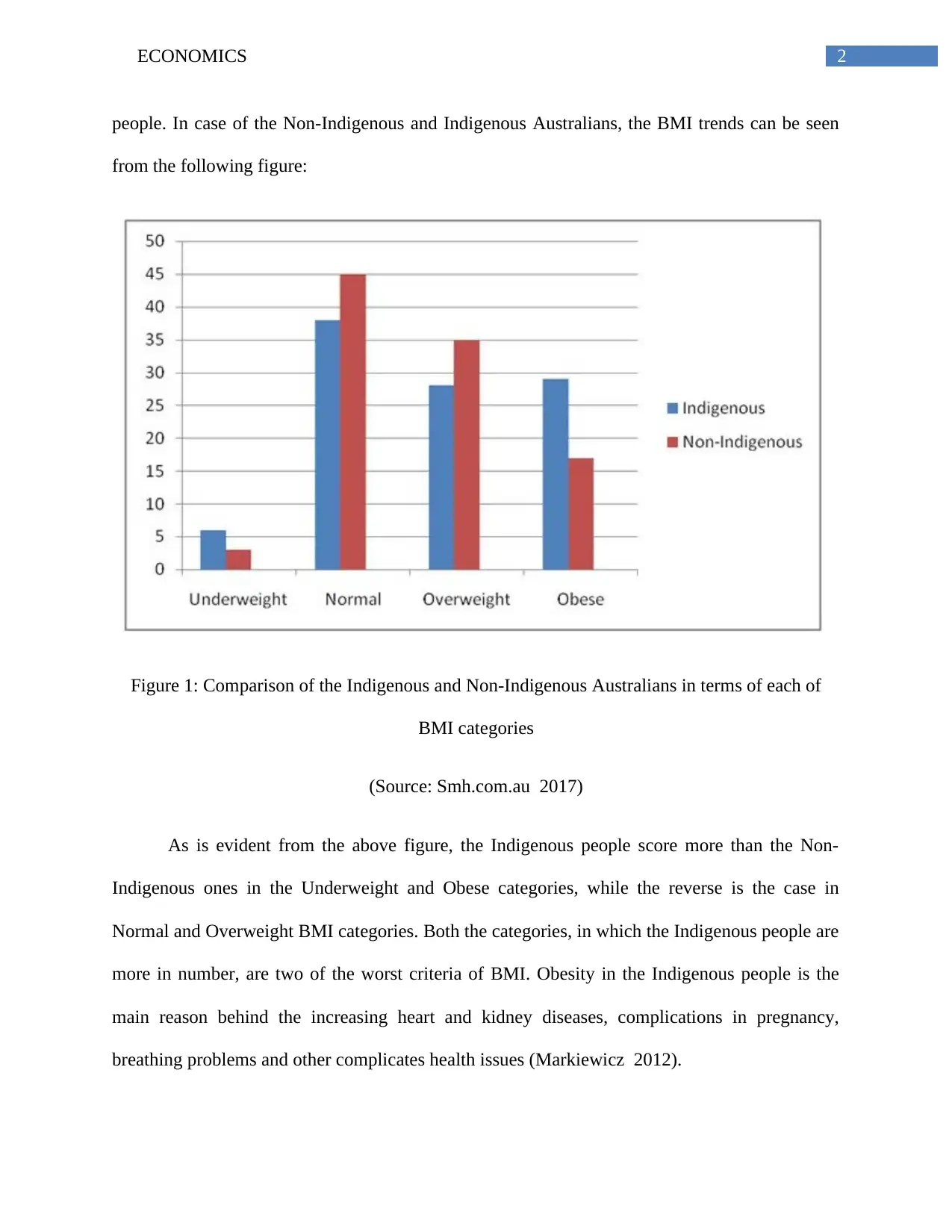
2ECONOMICS
people. In case of the Non-Indigenous and Indigenous Australians, the BMI trends can be seen
from the following figure:
Figure 1: Comparison of the Indigenous and Non-Indigenous Australians in terms of each of
BMI categories
(Source: Smh.com.au 2017)
As is evident from the above figure, the Indigenous people score more than the Non-
Indigenous ones in the Underweight and Obese categories, while the reverse is the case in
Normal and Overweight BMI categories. Both the categories, in which the Indigenous people are
more in number, are two of the worst criteria of BMI. Obesity in the Indigenous people is the
main reason behind the increasing heart and kidney diseases, complications in pregnancy,
breathing problems and other complicates health issues (Markiewicz 2012).
people. In case of the Non-Indigenous and Indigenous Australians, the BMI trends can be seen
from the following figure:
Figure 1: Comparison of the Indigenous and Non-Indigenous Australians in terms of each of
BMI categories
(Source: Smh.com.au 2017)
As is evident from the above figure, the Indigenous people score more than the Non-
Indigenous ones in the Underweight and Obese categories, while the reverse is the case in
Normal and Overweight BMI categories. Both the categories, in which the Indigenous people are
more in number, are two of the worst criteria of BMI. Obesity in the Indigenous people is the
main reason behind the increasing heart and kidney diseases, complications in pregnancy,
breathing problems and other complicates health issues (Markiewicz 2012).
⊘ This is a preview!⊘
Do you want full access?
Subscribe today to unlock all pages.

Trusted by 1+ million students worldwide
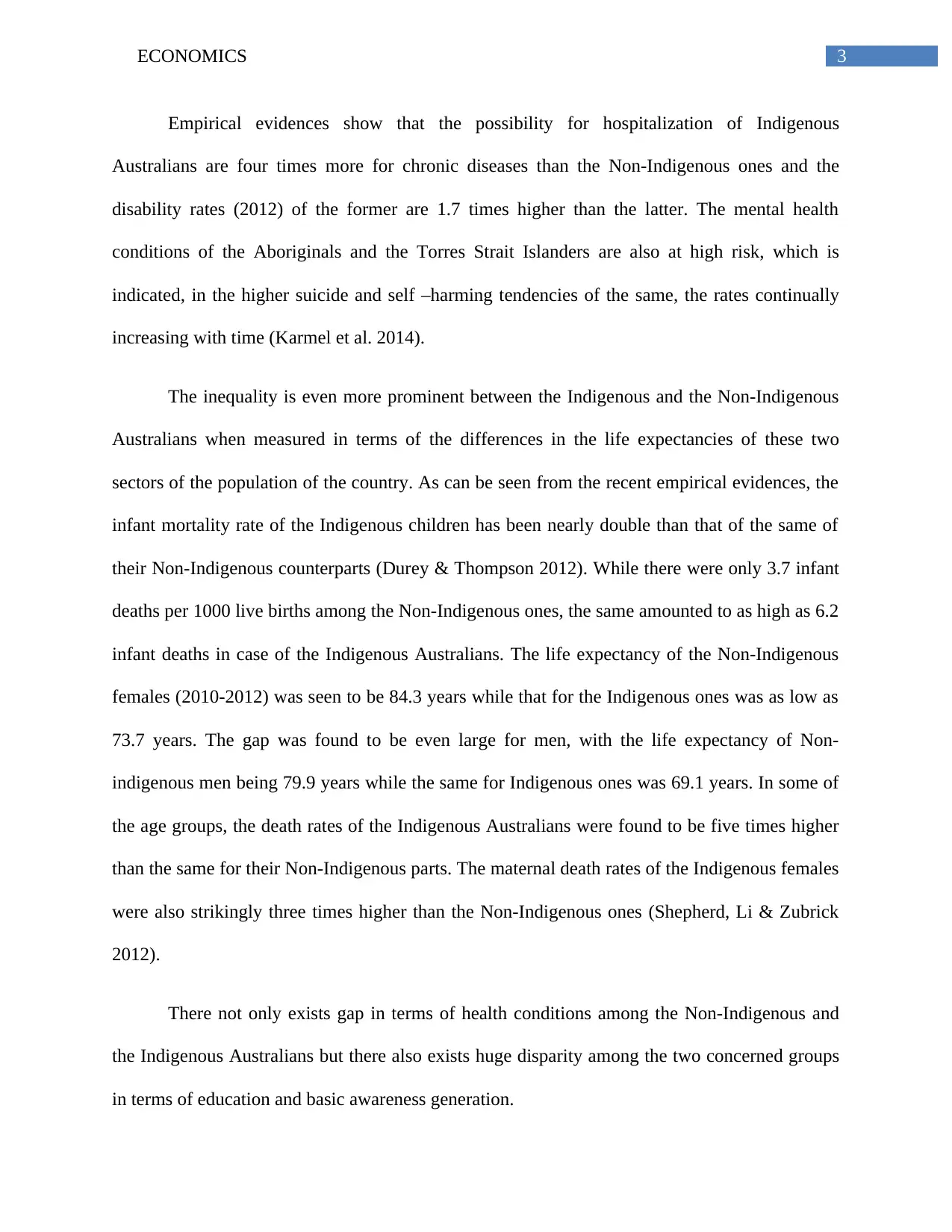
3ECONOMICS
Empirical evidences show that the possibility for hospitalization of Indigenous
Australians are four times more for chronic diseases than the Non-Indigenous ones and the
disability rates (2012) of the former are 1.7 times higher than the latter. The mental health
conditions of the Aboriginals and the Torres Strait Islanders are also at high risk, which is
indicated, in the higher suicide and self –harming tendencies of the same, the rates continually
increasing with time (Karmel et al. 2014).
The inequality is even more prominent between the Indigenous and the Non-Indigenous
Australians when measured in terms of the differences in the life expectancies of these two
sectors of the population of the country. As can be seen from the recent empirical evidences, the
infant mortality rate of the Indigenous children has been nearly double than that of the same of
their Non-Indigenous counterparts (Durey & Thompson 2012). While there were only 3.7 infant
deaths per 1000 live births among the Non-Indigenous ones, the same amounted to as high as 6.2
infant deaths in case of the Indigenous Australians. The life expectancy of the Non-Indigenous
females (2010-2012) was seen to be 84.3 years while that for the Indigenous ones was as low as
73.7 years. The gap was found to be even large for men, with the life expectancy of Non-
indigenous men being 79.9 years while the same for Indigenous ones was 69.1 years. In some of
the age groups, the death rates of the Indigenous Australians were found to be five times higher
than the same for their Non-Indigenous parts. The maternal death rates of the Indigenous females
were also strikingly three times higher than the Non-Indigenous ones (Shepherd, Li & Zubrick
2012).
There not only exists gap in terms of health conditions among the Non-Indigenous and
the Indigenous Australians but there also exists huge disparity among the two concerned groups
in terms of education and basic awareness generation.
Empirical evidences show that the possibility for hospitalization of Indigenous
Australians are four times more for chronic diseases than the Non-Indigenous ones and the
disability rates (2012) of the former are 1.7 times higher than the latter. The mental health
conditions of the Aboriginals and the Torres Strait Islanders are also at high risk, which is
indicated, in the higher suicide and self –harming tendencies of the same, the rates continually
increasing with time (Karmel et al. 2014).
The inequality is even more prominent between the Indigenous and the Non-Indigenous
Australians when measured in terms of the differences in the life expectancies of these two
sectors of the population of the country. As can be seen from the recent empirical evidences, the
infant mortality rate of the Indigenous children has been nearly double than that of the same of
their Non-Indigenous counterparts (Durey & Thompson 2012). While there were only 3.7 infant
deaths per 1000 live births among the Non-Indigenous ones, the same amounted to as high as 6.2
infant deaths in case of the Indigenous Australians. The life expectancy of the Non-Indigenous
females (2010-2012) was seen to be 84.3 years while that for the Indigenous ones was as low as
73.7 years. The gap was found to be even large for men, with the life expectancy of Non-
indigenous men being 79.9 years while the same for Indigenous ones was 69.1 years. In some of
the age groups, the death rates of the Indigenous Australians were found to be five times higher
than the same for their Non-Indigenous parts. The maternal death rates of the Indigenous females
were also strikingly three times higher than the Non-Indigenous ones (Shepherd, Li & Zubrick
2012).
There not only exists gap in terms of health conditions among the Non-Indigenous and
the Indigenous Australians but there also exists huge disparity among the two concerned groups
in terms of education and basic awareness generation.
Paraphrase This Document
Need a fresh take? Get an instant paraphrase of this document with our AI Paraphraser
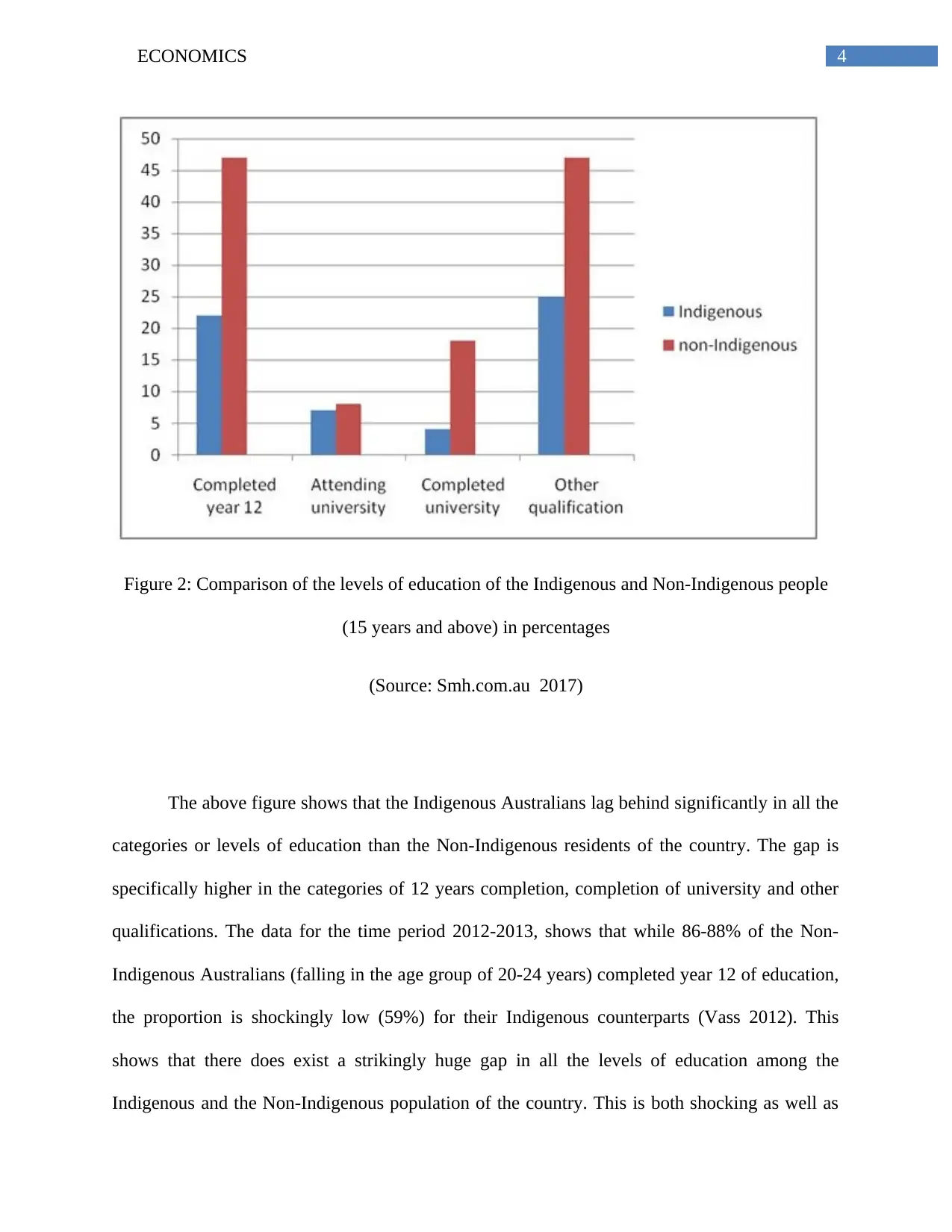
4ECONOMICS
Figure 2: Comparison of the levels of education of the Indigenous and Non-Indigenous people
(15 years and above) in percentages
(Source: Smh.com.au 2017)
The above figure shows that the Indigenous Australians lag behind significantly in all the
categories or levels of education than the Non-Indigenous residents of the country. The gap is
specifically higher in the categories of 12 years completion, completion of university and other
qualifications. The data for the time period 2012-2013, shows that while 86-88% of the Non-
Indigenous Australians (falling in the age group of 20-24 years) completed year 12 of education,
the proportion is shockingly low (59%) for their Indigenous counterparts (Vass 2012). This
shows that there does exist a strikingly huge gap in all the levels of education among the
Indigenous and the Non-Indigenous population of the country. This is both shocking as well as
Figure 2: Comparison of the levels of education of the Indigenous and Non-Indigenous people
(15 years and above) in percentages
(Source: Smh.com.au 2017)
The above figure shows that the Indigenous Australians lag behind significantly in all the
categories or levels of education than the Non-Indigenous residents of the country. The gap is
specifically higher in the categories of 12 years completion, completion of university and other
qualifications. The data for the time period 2012-2013, shows that while 86-88% of the Non-
Indigenous Australians (falling in the age group of 20-24 years) completed year 12 of education,
the proportion is shockingly low (59%) for their Indigenous counterparts (Vass 2012). This
shows that there does exist a strikingly huge gap in all the levels of education among the
Indigenous and the Non-Indigenous population of the country. This is both shocking as well as
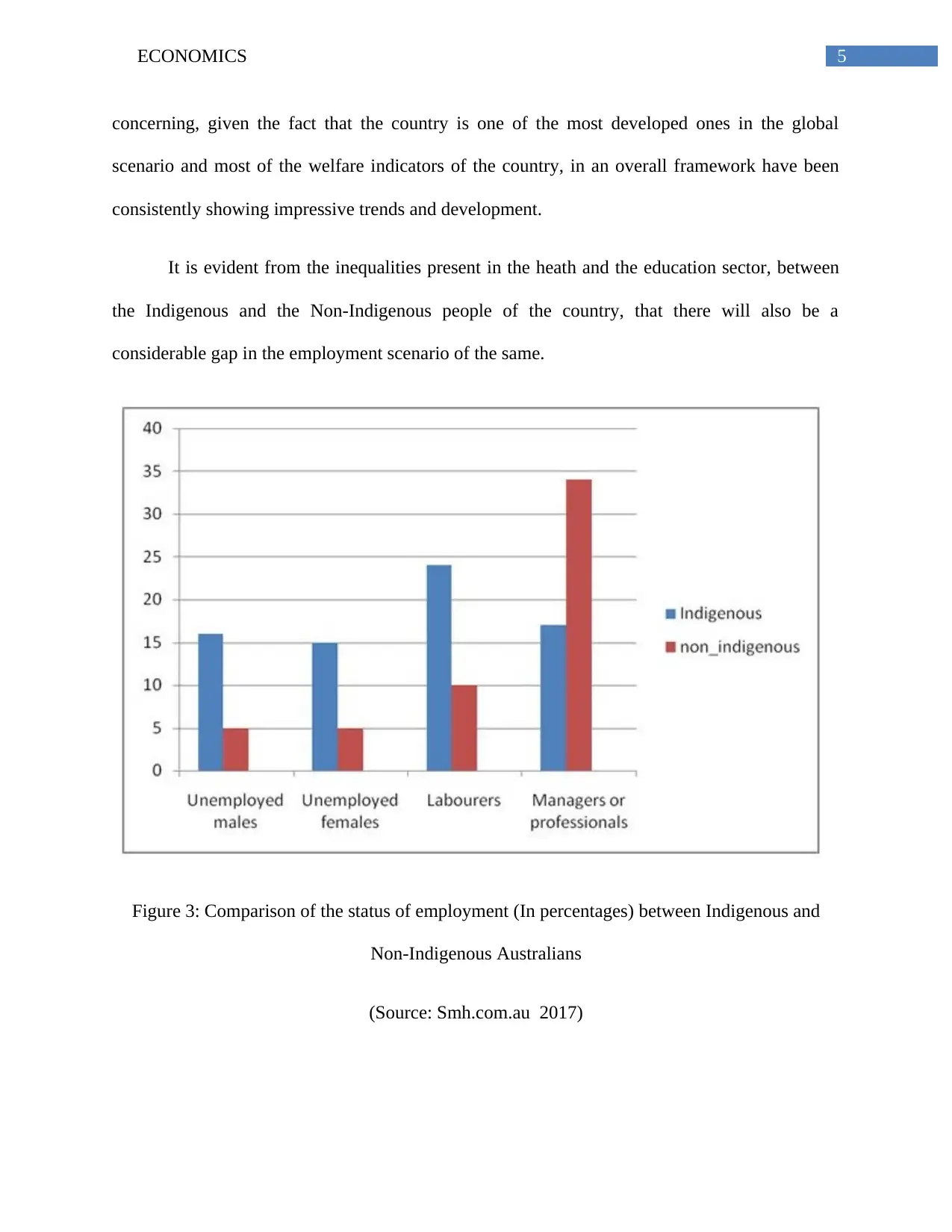
5ECONOMICS
concerning, given the fact that the country is one of the most developed ones in the global
scenario and most of the welfare indicators of the country, in an overall framework have been
consistently showing impressive trends and development.
It is evident from the inequalities present in the heath and the education sector, between
the Indigenous and the Non-Indigenous people of the country, that there will also be a
considerable gap in the employment scenario of the same.
Figure 3: Comparison of the status of employment (In percentages) between Indigenous and
Non-Indigenous Australians
(Source: Smh.com.au 2017)
concerning, given the fact that the country is one of the most developed ones in the global
scenario and most of the welfare indicators of the country, in an overall framework have been
consistently showing impressive trends and development.
It is evident from the inequalities present in the heath and the education sector, between
the Indigenous and the Non-Indigenous people of the country, that there will also be a
considerable gap in the employment scenario of the same.
Figure 3: Comparison of the status of employment (In percentages) between Indigenous and
Non-Indigenous Australians
(Source: Smh.com.au 2017)
⊘ This is a preview!⊘
Do you want full access?
Subscribe today to unlock all pages.

Trusted by 1+ million students worldwide
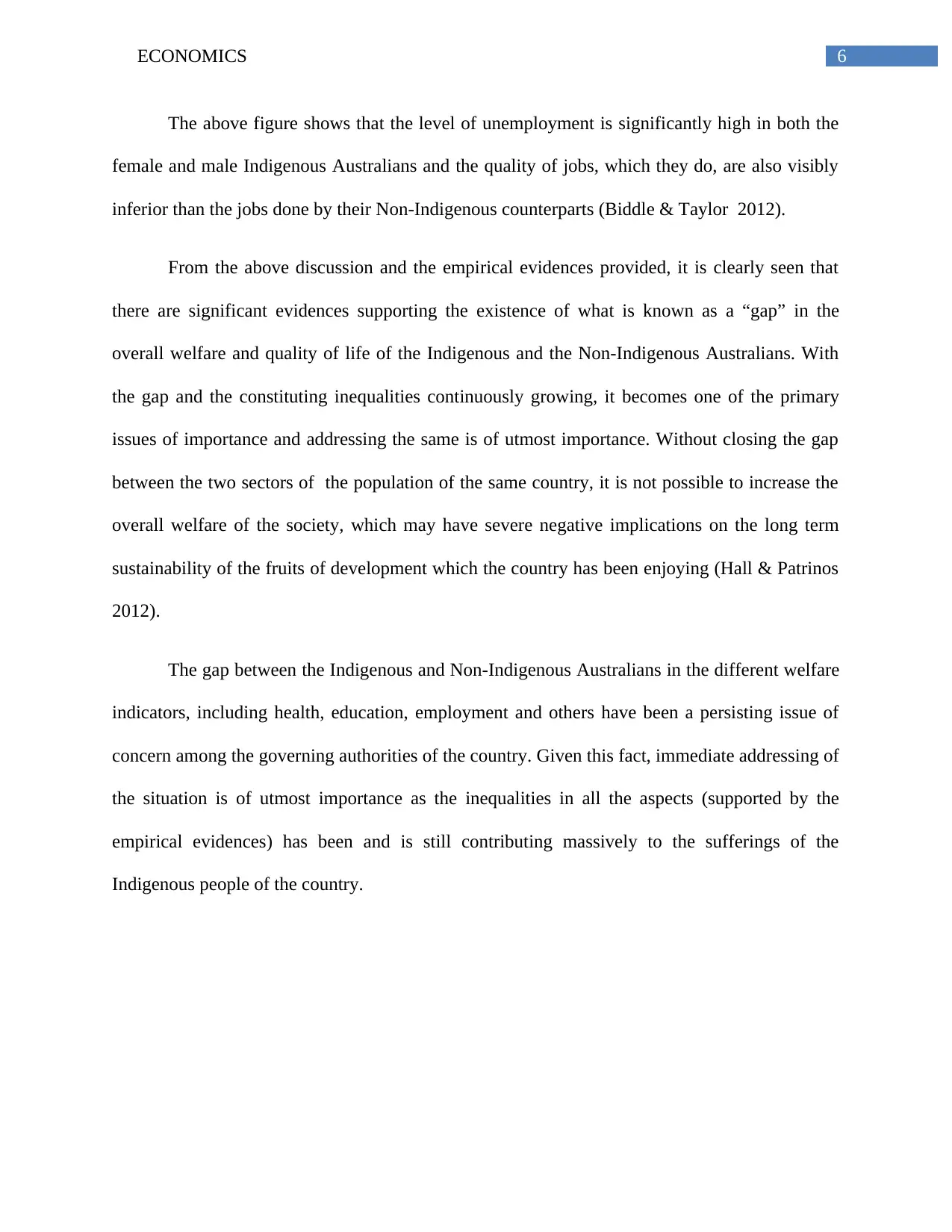
6ECONOMICS
The above figure shows that the level of unemployment is significantly high in both the
female and male Indigenous Australians and the quality of jobs, which they do, are also visibly
inferior than the jobs done by their Non-Indigenous counterparts (Biddle & Taylor 2012).
From the above discussion and the empirical evidences provided, it is clearly seen that
there are significant evidences supporting the existence of what is known as a “gap” in the
overall welfare and quality of life of the Indigenous and the Non-Indigenous Australians. With
the gap and the constituting inequalities continuously growing, it becomes one of the primary
issues of importance and addressing the same is of utmost importance. Without closing the gap
between the two sectors of the population of the same country, it is not possible to increase the
overall welfare of the society, which may have severe negative implications on the long term
sustainability of the fruits of development which the country has been enjoying (Hall & Patrinos
2012).
The gap between the Indigenous and Non-Indigenous Australians in the different welfare
indicators, including health, education, employment and others have been a persisting issue of
concern among the governing authorities of the country. Given this fact, immediate addressing of
the situation is of utmost importance as the inequalities in all the aspects (supported by the
empirical evidences) has been and is still contributing massively to the sufferings of the
Indigenous people of the country.
The above figure shows that the level of unemployment is significantly high in both the
female and male Indigenous Australians and the quality of jobs, which they do, are also visibly
inferior than the jobs done by their Non-Indigenous counterparts (Biddle & Taylor 2012).
From the above discussion and the empirical evidences provided, it is clearly seen that
there are significant evidences supporting the existence of what is known as a “gap” in the
overall welfare and quality of life of the Indigenous and the Non-Indigenous Australians. With
the gap and the constituting inequalities continuously growing, it becomes one of the primary
issues of importance and addressing the same is of utmost importance. Without closing the gap
between the two sectors of the population of the same country, it is not possible to increase the
overall welfare of the society, which may have severe negative implications on the long term
sustainability of the fruits of development which the country has been enjoying (Hall & Patrinos
2012).
The gap between the Indigenous and Non-Indigenous Australians in the different welfare
indicators, including health, education, employment and others have been a persisting issue of
concern among the governing authorities of the country. Given this fact, immediate addressing of
the situation is of utmost importance as the inequalities in all the aspects (supported by the
empirical evidences) has been and is still contributing massively to the sufferings of the
Indigenous people of the country.
Paraphrase This Document
Need a fresh take? Get an instant paraphrase of this document with our AI Paraphraser
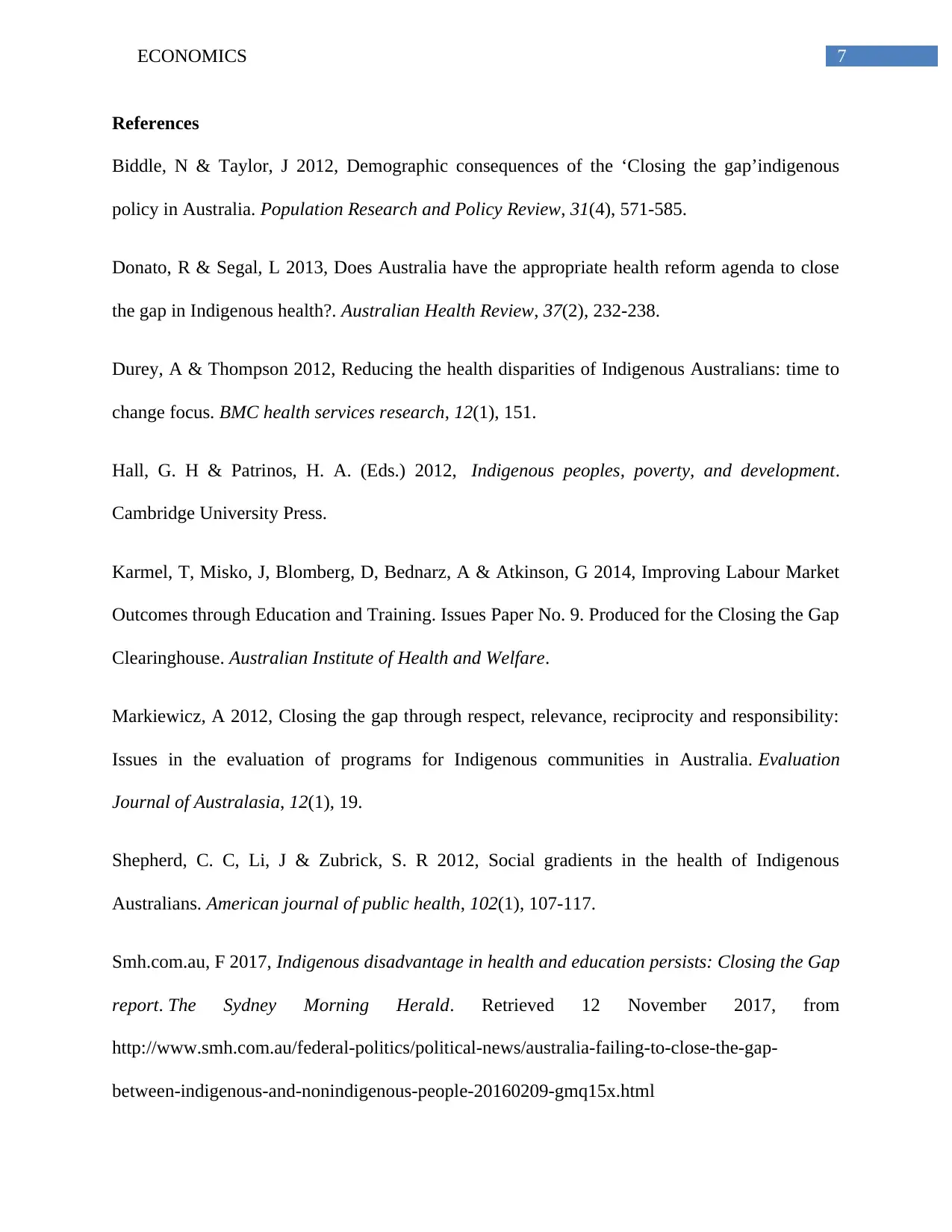
7ECONOMICS
References
Biddle, N & Taylor, J 2012, Demographic consequences of the ‘Closing the gap’indigenous
policy in Australia. Population Research and Policy Review, 31(4), 571-585.
Donato, R & Segal, L 2013, Does Australia have the appropriate health reform agenda to close
the gap in Indigenous health?. Australian Health Review, 37(2), 232-238.
Durey, A & Thompson 2012, Reducing the health disparities of Indigenous Australians: time to
change focus. BMC health services research, 12(1), 151.
Hall, G. H & Patrinos, H. A. (Eds.) 2012, Indigenous peoples, poverty, and development.
Cambridge University Press.
Karmel, T, Misko, J, Blomberg, D, Bednarz, A & Atkinson, G 2014, Improving Labour Market
Outcomes through Education and Training. Issues Paper No. 9. Produced for the Closing the Gap
Clearinghouse. Australian Institute of Health and Welfare.
Markiewicz, A 2012, Closing the gap through respect, relevance, reciprocity and responsibility:
Issues in the evaluation of programs for Indigenous communities in Australia. Evaluation
Journal of Australasia, 12(1), 19.
Shepherd, C. C, Li, J & Zubrick, S. R 2012, Social gradients in the health of Indigenous
Australians. American journal of public health, 102(1), 107-117.
Smh.com.au, F 2017, Indigenous disadvantage in health and education persists: Closing the Gap
report. The Sydney Morning Herald. Retrieved 12 November 2017, from
http://www.smh.com.au/federal-politics/political-news/australia-failing-to-close-the-gap-
between-indigenous-and-nonindigenous-people-20160209-gmq15x.html
References
Biddle, N & Taylor, J 2012, Demographic consequences of the ‘Closing the gap’indigenous
policy in Australia. Population Research and Policy Review, 31(4), 571-585.
Donato, R & Segal, L 2013, Does Australia have the appropriate health reform agenda to close
the gap in Indigenous health?. Australian Health Review, 37(2), 232-238.
Durey, A & Thompson 2012, Reducing the health disparities of Indigenous Australians: time to
change focus. BMC health services research, 12(1), 151.
Hall, G. H & Patrinos, H. A. (Eds.) 2012, Indigenous peoples, poverty, and development.
Cambridge University Press.
Karmel, T, Misko, J, Blomberg, D, Bednarz, A & Atkinson, G 2014, Improving Labour Market
Outcomes through Education and Training. Issues Paper No. 9. Produced for the Closing the Gap
Clearinghouse. Australian Institute of Health and Welfare.
Markiewicz, A 2012, Closing the gap through respect, relevance, reciprocity and responsibility:
Issues in the evaluation of programs for Indigenous communities in Australia. Evaluation
Journal of Australasia, 12(1), 19.
Shepherd, C. C, Li, J & Zubrick, S. R 2012, Social gradients in the health of Indigenous
Australians. American journal of public health, 102(1), 107-117.
Smh.com.au, F 2017, Indigenous disadvantage in health and education persists: Closing the Gap
report. The Sydney Morning Herald. Retrieved 12 November 2017, from
http://www.smh.com.au/federal-politics/political-news/australia-failing-to-close-the-gap-
between-indigenous-and-nonindigenous-people-20160209-gmq15x.html
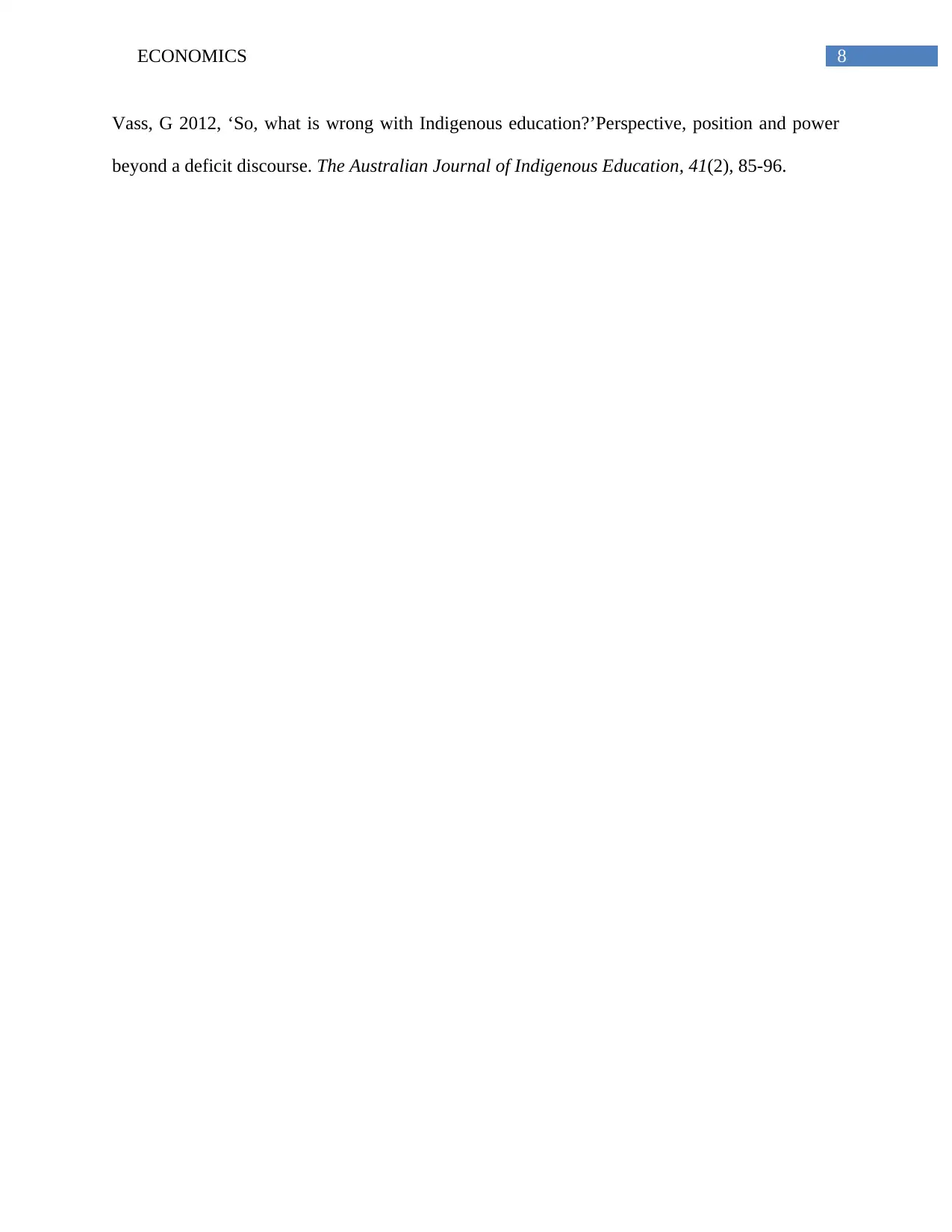
8ECONOMICS
Vass, G 2012, ‘So, what is wrong with Indigenous education?’Perspective, position and power
beyond a deficit discourse. The Australian Journal of Indigenous Education, 41(2), 85-96.
Vass, G 2012, ‘So, what is wrong with Indigenous education?’Perspective, position and power
beyond a deficit discourse. The Australian Journal of Indigenous Education, 41(2), 85-96.
⊘ This is a preview!⊘
Do you want full access?
Subscribe today to unlock all pages.

Trusted by 1+ million students worldwide
1 out of 9
Related Documents
Your All-in-One AI-Powered Toolkit for Academic Success.
+13062052269
info@desklib.com
Available 24*7 on WhatsApp / Email
![[object Object]](/_next/static/media/star-bottom.7253800d.svg)
Unlock your academic potential
Copyright © 2020–2025 A2Z Services. All Rights Reserved. Developed and managed by ZUCOL.




